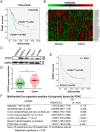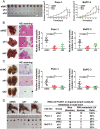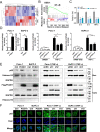PCDH1 promotes progression of pancreatic ductal adenocarcinoma via activation of NF-κB signalling by interacting with KPNB1
- PMID: 35864095
- PMCID: PMC9304345
- DOI: 10.1038/s41419-022-05087-y
PCDH1 promotes progression of pancreatic ductal adenocarcinoma via activation of NF-κB signalling by interacting with KPNB1
Erratum in
-
Correction: PCDH1 promotes progression of pancreatic ductal adenocarcinoma via activation of NF-κB signalling by interacting with KPNB1.Cell Death Dis. 2024 Jan 9;15(1):22. doi: 10.1038/s41419-023-06403-w. Cell Death Dis. 2024. PMID: 38195622 Free PMC article. No abstract available.
Abstract
Uncontrolled growth, distant metastasis and chemoresistance are critical characteristics of pancreatic ductal adenocarcinoma (PDAC), and they result in high mortality; however, the mechanisms triggering these effects have not been fully investigated. In this study, we analysed a dataset in the Cancer Genome Atlas (TCGA) and identified PCDH1, a rarely studied transmembrane protein, as a novel prognostic marker in PDAC patients. We demonstrated that PCDH1 expression was upregulated in PDAC tissues, and its expression levels were associated with the depth of tumour invasion and lymph node metastasis. Patients with high PCDH1 levels showed poor overall survival (OS). We also investigated the biological significance of PCDH1 in PDAC cell growth, metastasis, and side population (SP) phenotype acquisition and explored the internal molecular mechanisms of PCDH1 action. Our results demonstrated that PCDH1 enhanced p65 nuclear localization by interacting with KPNB1, a well-characterized nuclear transporter, thereby activating the NF-κB signalling pathway and increasing its functional effects during PDAC progression. Hence, our results indicate that PCDH1 can be used as a negative prognostic marker and may be a potential therapeutic target for PDAC patients.
© 2022. The Author(s).
Conflict of interest statement
The authors declare no competing interests.
Figures






Similar articles
-
Dysbindin promotes pancreatic ductal adenocarcinoma metastasis by activating NF-κB/MDM2 via miR-342-3p.Cancer Lett. 2020 May 1;477:107-121. doi: 10.1016/j.canlet.2020.02.033. Epub 2020 Feb 29. Cancer Lett. 2020. PMID: 32120026
-
SERP1 is a novel marker of poor prognosis in pancreatic ductal adenocarcinoma patients via anti-apoptosis and regulating SRPRB/NF-κB axis.Int J Oncol. 2017 Oct;51(4):1104-1114. doi: 10.3892/ijo.2017.4111. Epub 2017 Aug 31. Int J Oncol. 2017. PMID: 28902358 Free PMC article.
-
PCDH1, a poor prognostic biomarker and potential target for pancreatic adenocarcinoma metastatic therapy.BMC Cancer. 2023 Nov 13;23(1):1102. doi: 10.1186/s12885-023-11474-1. BMC Cancer. 2023. PMID: 37957639 Free PMC article.
-
Advancement of NF-κB Signaling Pathway: A Novel Target in Pancreatic Cancer.Int J Mol Sci. 2018 Dec 5;19(12):3890. doi: 10.3390/ijms19123890. Int J Mol Sci. 2018. PMID: 30563089 Free PMC article. Review.
-
Localisation of PGK1 determines metabolic phenotype to balance metastasis and proliferation in patients with SMAD4-negative pancreatic cancer.Gut. 2020 May;69(5):888-900. doi: 10.1136/gutjnl-2018-317163. Epub 2019 Oct 14. Gut. 2020. PMID: 31611300 Review.
Cited by
-
Identification of key regulators in pancreatic ductal adenocarcinoma using network theoretical approach.PLoS One. 2025 Jan 27;20(1):e0313738. doi: 10.1371/journal.pone.0313738. eCollection 2025. PLoS One. 2025. PMID: 39869563 Free PMC article.
-
Nuclear transport proteins: structure, function, and disease relevance.Signal Transduct Target Ther. 2023 Nov 10;8(1):425. doi: 10.1038/s41392-023-01649-4. Signal Transduct Target Ther. 2023. PMID: 37945593 Free PMC article. Review.
-
Protocadherin-1 serves as a prognostic biomarker and promotes pancreatic cancer progression by suppressing CD8+ T cell infiltration through CCL5-CCR5 axis.Am J Cancer Res. 2023 Nov 15;13(11):5197-5217. eCollection 2023. Am J Cancer Res. 2023. PMID: 38058826 Free PMC article.
-
Survival-Associated Cellular Response Maintained in Pancreatic Ductal Adenocarcinoma (PDAC) Switched Between Soft and Stiff 3D Microgel Culture.ACS Biomater Sci Eng. 2024 Apr 8;10(4):2177-2187. doi: 10.1021/acsbiomaterials.3c01079. Epub 2024 Mar 11. ACS Biomater Sci Eng. 2024. PMID: 38466617 Free PMC article.
-
TMEM209 promotes hepatocellular carcinoma progression by activating the Wnt/β-catenin signaling pathway through KPNB1 stabilization.Cell Death Discov. 2024 Oct 16;10(1):438. doi: 10.1038/s41420-024-02207-9. Cell Death Discov. 2024. PMID: 39414762 Free PMC article.
References
-
- Chen W, Zheng R, Baade PD, Zhang S, Zeng H, Bray F, et al. Cancer statistics in China, 2015. CA: Cancer J Clin. 2016;66:115–32. - PubMed
Publication types
MeSH terms
Substances
LinkOut - more resources
Full Text Sources
Medical
Molecular Biology Databases
Miscellaneous

